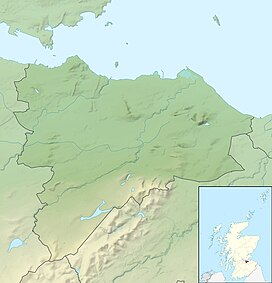
Back جبل ارثرس سيات ARZ Kador Arzhur Breton Arthur's Seat Catalan Arthur's Seat (bungtod sa Hiniusang Gingharian) CEB Arthur's Seat Czech Arthur’s Seat (Edinburgh) German Κάθισμα του Αρθούρου Greek Arthur's Seat Esperanto Arthur's Seat Spanish Arthur's Seat Basque
| Arthur's Seat | |
|---|---|
 | |
| Highest point | |
| Elevation | 251 m (823 ft) |
| Prominence | 174 m (571 ft)[1] [2] |
| Isolation | 6.93 km (4.31 mi) |
| Listing | Marilyn |
| Coordinates | 55°56′39″N 3°09′43″W / 55.94417°N 3.16194°W |
| Geography | |
| Location | Edinburgh, Scotland |
| OS grid | NT27537295 |
| Topo map | OS Landranger 66 |
| Climbing | |
| Easiest route | hillwalking |

Arthur's Seat (Scottish Gaelic: Suidhe Artair, pronounced [ˈs̪ɯi.əˈaɾt̪ʰəɾʲ]) is an ancient extinct volcano that is the main peak of the group of hills in Edinburgh, Scotland, which form most of Holyrood Park, described by Robert Louis Stevenson as "a hill for magnitude, a mountain in virtue of its bold design".[3] It is situated just to the east of the city centre, about 1 mile (1.6 km) to the east of Edinburgh Castle. The hill rises above the city to a height of 250.5 m (822 ft), provides excellent panoramic views of the city and beyond, is relatively easy to climb, and is popular for hillwalking. Though it can be climbed from almost any direction, the easiest ascent is from the east, where a grassy slope rises above Dunsapie Loch. At a spur of the hill, Salisbury Crags has historically been a rock climbing venue with routes of various degrees of difficulty. Rock climbing was restricted to the South Quarry, but access was banned altogether in 2019 by Historic Environment Scotland.[4]
- ^ https://www.hill-bagging.co.uk/hill-view/?rf=1828
- ^ https://www.peakbagger.com/peak.aspx?pid=9320
- ^ Stevenson, Robert Louis (1879). Edinburgh: Picturesque Notes. p. 21.
- ^ "No Radical Road for Historic Environment Scotland - the Salisbury crags access debacle". parkswatchscotland. 10 February 2022. Retrieved 19 April 2022.


